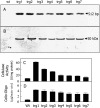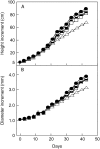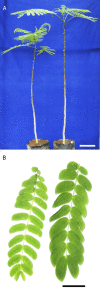Overexpression of poplar cellulase accelerates growth and disturbs the closing movements of leaves in sengon
- PMID: 18417637
- PMCID: PMC2409039
- DOI: 10.1104/pp.108.116970
Overexpression of poplar cellulase accelerates growth and disturbs the closing movements of leaves in sengon
Abstract
In this study, poplar (Populus alba) cellulase (PaPopCel1) was overexpressed in a tropical Leguminosae tree, sengon (Paraserianthes falcataria), by the Agrobacterium tumefaciens method. PaPopCel1 overexpression increased the length and width of stems with larger leaves, which showed a moderately higher density of green color than leaves of the wild type. The pairs of leaves on the transgenic plants closed more slowly during sunset than those on the wild-type plants. When main veins from each genotype were excised and placed on a paper towel, however, the leaves of the transgenic plants closed more rapidly than those of the wild-type plant. Based on carbohydrate analyses of cell walls, the leaves of the transgenic plants contained less wall-bound xyloglucan than those of the wild-type plants. In situ xyloglucan endotransglucosylase activity showed that the incorporation of whole xyloglucan, potentially for wall tightening, occurred in the parenchyma cells (motor cells) of the petiolule pulvinus attached to the main vein, although the transgenic plant incorporated less whole xyloglucan than the wild-type plant. These observations support the hypothesis that the paracrystalline sites of cellulose microfibrils are attacked by poplar cellulase, which loosens xyloglucan intercalation, resulting in an irreversible wall modification. This process could be the reason why the overexpression of poplar cellulase both promotes plant growth and disturbs the biological clock of the plant by altering the closing movements of the leaves of the plant.
Figures







References
-
- Binkley D, Senock R, Bird S, Cole TG (2003) Twenty years of stand development in pure and mixed stands of Eucalyptus saligna and nitrogen-fixing Facaltaria moluccana. For Ecol Manage 182 93–102
-
- Bon MC, Bonal D, Goh DK, Monteuuis O (1998) Influence of different macronutrient solutions and growth regulators on micropropagation of juvenile Acacia mangium and Paraserianthes falcataria explants. Plant Cell Tissue Organ Cult 53 171–177
-
- Bradford MN (1976) A rapid and sensitive method for the quantitation of microgram quantities of protein utilizing the principle of protein-dye binding. Anal Biochem 72 248–254 - PubMed
-
- Darwin C (1880) The Power of Movement in Plants. John Murray, London
Publication types
MeSH terms
Substances
Associated data
- Actions
LinkOut - more resources
Full Text Sources
Other Literature Sources
Miscellaneous

